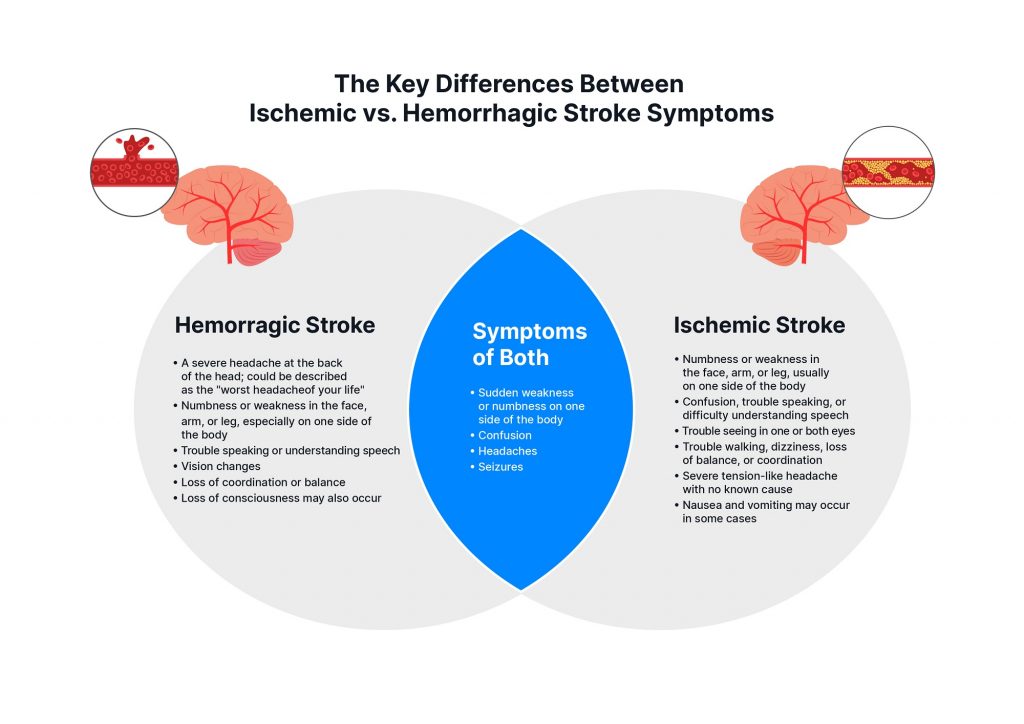
Ischemic vs. Hemorrhagic Stroke Symptoms

A stroke is a life-altering experience. The subsequent emotional, mental, and physical changes often introduce new challenges for survivors and their loved ones as they navigate a new life. We should all have empathy and compassion for anyone who has gone through this.
Understanding the two types of strokes and how they impact each individual is essential. An ischemic stroke happens when the blood supply to the brain gets interrupted. A broken blood vessel that allows bleeding to occur in the brain causes a hemorrhagic stroke. In either situation, seek medical treatment immediately.
Here’s more about ischemic vs. hemorrhagic stroke symptoms and the steps to take if a stroke impacts you or someone you love.

The Key Differences Between Ischemic vs. Hemorrhagic Stroke Symptoms
The brain is a powerful yet delicate organ that enables the body to participate in countless activities. But when this organ experiences a stroke, it can manifest in several ways. These manifestations can, unfortunately, make even routine activities we took for granted much more difficult.
Both ischemic and hemorrhagic strokes minimize blood flow to the brain. Some of the symptoms of both types include:
- Sudden weakness or numbness on one side of the body
- Confusion
- Headaches
- Seizures
It’s important to know that frequency and symptom type can vary when comparing ischemic and hemorrhagic strokes. For example, seizures are more common in hemorrhagic stroke patients, while nausea and vomiting occur more often with ischemic strokes. Both ischemic and hemorrhagic strokes may involve headaches, but those experiencing hemorrhagic strokes are more likely to have sudden, severe pain in the back of the head.
No matter what symptoms you or a loved one face, it’s critical to seek medical attention immediately if any of these signs are present.

Understanding Ischemic Stroke
Ischemic stroke happens in response to a blockage of the blood supply to the brain. This blockage prevents brain tissue from getting the necessary oxygen and nutrients.
Ischemic strokes “account for about 87% of all strokes.” The two types of ischemic strokes are:
- Thrombotic stroke: Caused by a blood clot that builds in an artery that supplies blood to the brain
- Embolic stroke: Caused by a clot that forms in the body and travels through the blood vessels to the brain
Common Symptoms
The severity of ischemic stroke symptoms can differ depending on the location and impact of the stroke. These can include sudden:
- Numbness or weakness in the face, arm, or leg, usually on one side of the body
- Confusion, trouble speaking, or difficulty understanding speech
- Trouble seeing in one or both eyes
- Trouble walking, dizziness, loss of balance, or coordination
- Severe tension-like headache with no known cause
Additional symptoms, such as nausea and vomiting, may occur in some cases.
Understanding Hemorrhagic Stroke
Hemorrhagic strokes happen due to weak blood vessels that rupture and bleed into the brain. This stroke category is further split into two sub-categories:
- Intracerebral hemorrhage: Bleeding into the brain tissue
- Subarachnoid hemorrhage: Bleeding in the space that surrounds the brain
Common Symptoms
Common symptoms of hemorrhagic stroke involve a sudden onset of:
- A severe headache at the back of the head; could be described as the “worst headache of your life”
- Numbness or weakness in the face, arm, or leg, especially on one side of the body
- Trouble speaking or understanding speech
- Vision changes
- Loss of coordination or balance
- Seizures and loss of consciousness may also occur.
Again, we strongly urge you to seek medical attention if you or someone you know experiences any of the symptoms of an ischemic or hemorrhagic stroke.
You can also learn about the 5 things you can do to help a stroke victim recover – or Ways to Enhance Your Post-Stroke Journey: 3 Brain Exercises to Consider.
It’s Never Too Late to Seek Help for Stroke Recovery

Recovery after a stroke is a unique journey for each survivor, and timelines can vary greatly—it’s common and understandable to feel discouraged along the way. Stroke recovery is not always linear and can involve ups and downs. But If it’s been months or even years after the stroke incident and your progress still isn’t where you want to be, you can still have hope.
Backed by a diverse medical staff and over a decade of leading research, the Aviv Clinics team is here to help you be empowered. Our post-stroke program has revitalized individuals’ cognitive and physical capabilities, even years after a stroke.
Contact us today to learn if the Aviv Clinics stroke recovery program is right for you or your loved one.
Watch Cindy’s Remarkable Recovery Story
Aviv Medical Program provides you with a unique opportunity to invest in your health while you age




